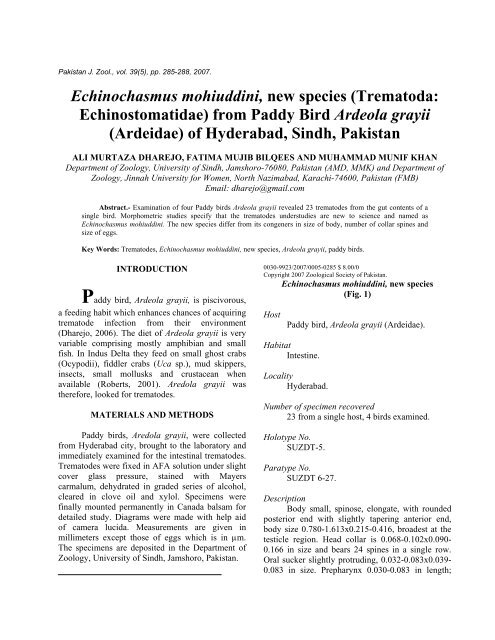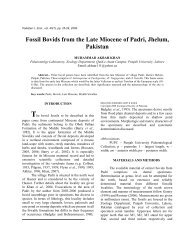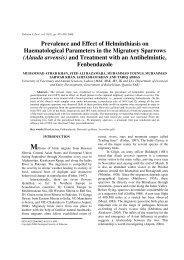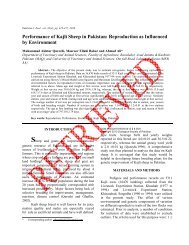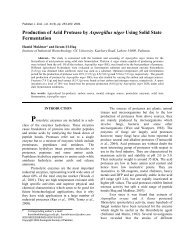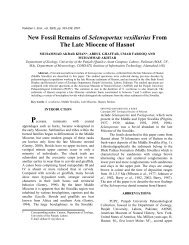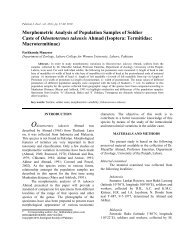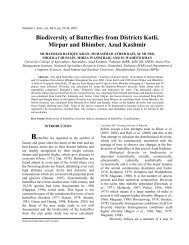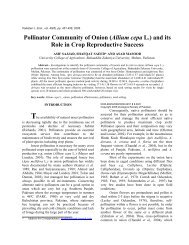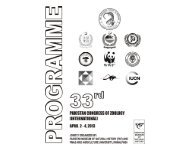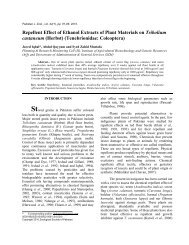Echinochasmus mohiuddini new species - Zoological Society Of ...
Echinochasmus mohiuddini new species - Zoological Society Of ...
Echinochasmus mohiuddini new species - Zoological Society Of ...
Create successful ePaper yourself
Turn your PDF publications into a flip-book with our unique Google optimized e-Paper software.
Pakistan J. Zool., vol. 39(5), pp. 285-288, 2007.<br />
<strong>Echinochasmus</strong> <strong>mohiuddini</strong>, <strong>new</strong> <strong>species</strong> (Trematoda:<br />
Echinostomatidae) from Paddy Bird Ardeola grayii<br />
(Ardeidae) of Hyderabad, Sindh, Pakistan<br />
ALI MURTAZA DHAREJO, FATIMA MUJIB BILQEES AND MUHAMMAD MUNIF KHAN<br />
Department of Zoology, University of Sindh, Jamshoro-76080, Pakistan (AMD, MMK) and Department of<br />
Zoology, Jinnah University for Women, North Nazimabad, Karachi-74600, Pakistan (FMB)<br />
Email: dharejo@gmail.com<br />
Abstract.- Examination of four Paddy birds Ardeola grayii revealed 23 trematodes from the gut contents of a<br />
single bird. Morphometric studies specify that the trematodes understudies are <strong>new</strong> to science and named as<br />
<strong>Echinochasmus</strong> <strong>mohiuddini</strong>. The <strong>new</strong> <strong>species</strong> differ from its congeners in size of body, number of collar spines and<br />
size of eggs.<br />
Key Words: Trematodes, <strong>Echinochasmus</strong> <strong>mohiuddini</strong>, <strong>new</strong> <strong>species</strong>, Ardeola grayii, paddy birds.<br />
INTRODUCTION<br />
Paddy bird, Ardeola grayii, is piscivorous,<br />
a feeding habit which enhances chances of acquiring<br />
trematode infection from their environment<br />
(Dharejo, 2006). The diet of Ardeola grayii is very<br />
variable comprising mostly amphibian and small<br />
fish. In Indus Delta they feed on small ghost crabs<br />
(Ocypodii), fiddler crabs (Uca sp.), mud skippers,<br />
insects, small mollusks and crustacean when<br />
available (Roberts, 2001). Aredola grayii was<br />
therefore, looked for trematodes.<br />
MATERIALS AND METHODS<br />
Paddy birds, Aredola grayii, were collected<br />
from Hyderabad city, brought to the laboratory and<br />
immediately examined for the intestinal trematodes.<br />
Trematodes were fixed in AFA solution under slight<br />
cover glass pressure, stained with Mayers<br />
carmalum, dehydrated in graded series of alcohol,<br />
cleared in clove oil and xylol. Specimens were<br />
finally mounted permanently in Canada balsam for<br />
detailed study. Diagrams were made with help aid<br />
of camera lucida. Measurements are given in<br />
millimeters except those of eggs which is in µm.<br />
The specimens are deposited in the Department of<br />
Zoology, University of Sindh, Jamshoro, Pakistan.<br />
0030-9923/2007/0005-0285 $ 8.00/0<br />
Copyright 2007 <strong>Zoological</strong> <strong>Society</strong> of Pakistan.<br />
<strong>Echinochasmus</strong> <strong>mohiuddini</strong>, <strong>new</strong> <strong>species</strong><br />
(Fig. 1)<br />
Host<br />
Paddy bird, Ardeola grayii (Ardeidae).<br />
Habitat<br />
Intestine.<br />
Locality<br />
Hyderabad.<br />
Number of specimen recovered<br />
23 from a single host, 4 birds examined.<br />
Holotype No.<br />
SUZDT-5.<br />
Paratype No.<br />
SUZDT 6-27.<br />
Description<br />
Body small, spinose, elongate, with rounded<br />
posterior end with slightly tapering anterior end,<br />
body size 0.780-1.613x0.215-0.416, broadest at the<br />
testicle region. Head collar is 0.068-0.102x0.090-<br />
0.166 in size and bears 24 spines in a single row.<br />
Oral sucker slightly protruding, 0.032-0.083x0.039-<br />
0.083 in size. Prepharynx 0.030-0.083 in length;
286<br />
pharynx elongated to oval in shape measuring,<br />
0.045-0.098x0.030-0.071 followed by esophagus,<br />
A.M. DHAREJO ET AL.<br />
0.037 - 0.106 in length. Acetabulum situated in<br />
Fig. 1. <strong>Echinochasmus</strong> <strong>mohiuddini</strong>, <strong>new</strong> <strong>species</strong>; A, entire worm; B, head collar; C, cirrus pouch; D, eggs.<br />
Scale-bars: A, 0.5 mm; B, C, 0.2 mm; D, 100µm.<br />
middle of second quarter of body and measures,<br />
0.106-0.227x0.090-0.189 in diameter nearly twice<br />
as large as the oral sucker and also well apart from<br />
oral sucker at a distance of 0.219-0.401. Sucker<br />
width ratio is 1:2.28.<br />
Testes subequal, large, median, tandem,<br />
irregular in shape, slightly overlapping in some<br />
specimens; anterior testis lies slightly behind the<br />
middle of the body. Anterior testis 0.079-<br />
0.227x0.090-0.212 while posterior one is 0.109-<br />
0.280x0.090-0.204 in size. Cirrus sac small 0.030-<br />
0.128x0.041-0.075 in size, situated dorsally behind<br />
esophageal bifurcation and anterior to the ventral<br />
sucker.<br />
Ovary oval, 0.030-0.090x0.026-0.106 in size,<br />
submedian, and situated towards right of the middle
line and between ventral sucker and anterior testis.<br />
Vitellaria composed of large follicles extending<br />
backward from lower level of acetabulum in lateral<br />
fields and almost meet behind the posterior testis.<br />
Uterus short, confined between acetabulum and<br />
ovary with few windings and indistinct outline<br />
containing relatively few large eggs, 56-70x32-44 in<br />
size.<br />
DISCUSSION<br />
Tremadoes of birds show world wide<br />
distribution and a large number of trematode <strong>species</strong><br />
have been reported from several countries of the<br />
world (Yamaguti, 1971; Gibson, 2001). The genus<br />
<strong>Echinochasmus</strong> Dietz, 1909 was erected to<br />
accommodate trematodes from birds. Bhutta and<br />
Khan (1975) reported <strong>Echinochasmus</strong> accipteri,<br />
<strong>Echinochasmus</strong> amphibolus and <strong>Echinochasmus</strong><br />
bugulai from birds Accipter bodious, Gallimula<br />
chloropus and Ardeola grayii respectively from<br />
Pakistan. In this study a <strong>new</strong> <strong>species</strong> of the genus<br />
<strong>Echinochasmus</strong> Dietz, 1909 is reported from the<br />
intestine of Paddy bird Ardeola grayii of Hyderabad<br />
Sindh. The present <strong>new</strong> <strong>species</strong> is larger in size<br />
(0.780-1.613x0.215-0.416) than E. bagulai (0.77-<br />
1.35x0.26-0.4), E. zubedakhaname (0.74-1.25x0.22-<br />
0.39), E. beleocephalus (0.715-0.924x0.253-0.33),<br />
E. microacetabulum (0.702-0.936 x 0.28-0.34), E.<br />
japonicus (0.6-0.9x0.16-0.18), E. liliputanus (0.5-<br />
0.8x0.2) and E. milvi (0.7-1.2x0.27-0.32).<br />
The present specimen are smaller in size than<br />
E. antigonus (11.75-12.92x1.2-1.43), E. famelicus<br />
(8.65x1.55), E. tobi (6.5-7.5x1.1-1.3), E.<br />
amphibolus (4.16-5.16x0.765), E. euryporus (3-<br />
4x0.85), E. botauri (3.25x0.65), E. ruficapensis<br />
(2.5-3.5x0.4-0.6), E. pelecani (2.4-3.4), E. colymbi<br />
(2.37x0.725), E. novalichesensis (2.32-3.25x0.48-<br />
0.75), E. cohensi (2.2x-), E. coaxatus (2.13-<br />
2.56x0.65-0.81), E. mirus (2.08x0.48), E. spinosus<br />
(2.0-2.25x0.4-0.5), E. gorsaki (1.9-3.4x0.32-0.54),<br />
E. oligolecithosus (1.76x0.27), E. mordax (1.65x0.3<br />
– 0.35), E. squamatus (1.6-3.68x0.4-0.88), E.<br />
militaris (1.56-2.0x0.468-0.546), E. muraschkinzewi<br />
(1.48-1.72x0.36-0.385), E. dietzevi (1.13-1.47x0.39-<br />
0.55), E. haliasturis (1.1-1.9x0.8-0.9), E. spinulosus<br />
(1.09-2.7x0.41-0.43), E. megavitellus (1.05x0.45)<br />
and E. dona dsoni (0.88-1.84x0.256-0.32).<br />
ECHINOCHASMUS MOHIUDDINI, NEW SPECIES<br />
287<br />
The number of collar spines in the present<br />
<strong>species</strong> is 24, while it is 20 in E. dona dsoni and 22<br />
in E. dietzevi, E. euryporus, E. cohensi, E. gorsaki,<br />
E. microacetabulum, E. milvi, E. mordax, and E.<br />
muraschkinzewi. Whereas the number of collar<br />
spines is 22-24 in E. mirus. The number of collar<br />
spines in E. bagulai, E. japonicus, E. beleocephalus,<br />
E. beleococephalus chankensis, E. megavitellus, E.<br />
novalichesensis, E. oligolecithosus E. squamatus, E.<br />
tobi, E. liliputanus, E. militaris and E. famelicus is<br />
24<br />
The present specimen is different in having<br />
smaller eggs (56-70x32-40) than E. militaris (66.3-<br />
80x44-46.8), E. bagulai (66-75x42-51), E.<br />
liliputanus (66-80x43-46), E. euryporus (67x42),<br />
E. squamatus (67-68x48-52), E. dietzevi(67-79x46-<br />
58), E. militaris (68-77x46), E. spinulosus (69.6-<br />
72x48-54), E. haliasturis (69-72x45), E.<br />
megavitellus (70x50), E. ruficapensis (70-80x38-<br />
52), E. dona dsoni (72-76x50-54), E. gorsaki (72-<br />
90x51-57), E. mordax (73x50), E. beleocephalus<br />
(73-81x34-43), E. oligolecithosus (73-83x54-76), E.<br />
spinosus (74-80x40), E. microacetabulum (77x46),<br />
E. japonicus (77-90x51-57), E. milvi (78-84x51-57),<br />
E. muraschkinzewi (81-96x43-47), E.<br />
beleococephalus chankensis (84x50), E. coaxatus<br />
(84-86.4x57.6), E. cohensi (84-89x49-52.5), E.<br />
botauri (84-97x46-65), E. colymbi (89-97x55-58),<br />
E. mirus (92-100x48-56), E. novalichesensis (95.6-<br />
108x58.2-70.7), E. amphibolus (97.2-102.6x59.4-<br />
67.5), E. tobi (102-117x60-72), E. antigonus (104-<br />
126x57-68), E. famelicus (110-120x70-80). While<br />
the egg size of present <strong>species</strong> is larger than E.<br />
Zubedakhaname (42-67x32- 40).<br />
The above mentioned differences in<br />
diagnostic features of the present and previously<br />
described <strong>species</strong> of the genus <strong>Echinochasmus</strong><br />
substantiate the statement that the specimens<br />
understudy are <strong>new</strong> to science and named as<br />
<strong>Echinochasmus</strong> <strong>mohiuddini</strong>. Name of the <strong>species</strong><br />
refers to late Dr. Ahmed Mohiuddin, Professor of<br />
Zoology Department, University of Sindh,<br />
Jamshoro.<br />
REFERENCES<br />
BHUTTA, M.S. AND KHAN, D., 1975. Digenetic trematodes<br />
of vertebrates from Pakistan. Bull. Dept. Zool. Univ.
288<br />
Punjab, 8: 1-175.<br />
DHAREJO, A. M., BILQEES, F.M. AND KHAN. M.M., 2006.<br />
Paramonostomum (Paramonostomum)<br />
macrovesiculum, <strong>new</strong> <strong>species</strong> (Trematoda:<br />
Notocotylidae) from black coot, Fulica atra (Aves:<br />
Rallidae) of Hyderabad Sindh, Pakistan. Pakistan. J.<br />
Zool., 37: 313-316.<br />
GIBSON, D.I., JONES, A. AND BARY, A.R., 2001. Keys to<br />
the trematoda, vol. I. CABI Publishing and The Natural<br />
A.M. DHAREJO ET AL.<br />
History Museum, London, UK, pp. 521.<br />
ROBERTS, T. J., 1991. The birds of Pakistan, vol. I. Non-<br />
Passeriformes. Oxford University Press, Karachi, pp.<br />
598.<br />
YAMAGUTI, S., 1971. Synopsis of digenetic trematodes of<br />
vertebrates Vol. I and II. Keigaku Publishing Co.<br />
Tokyo, Japan, pp. 1575.<br />
(Received 5 April 2007, revised 20 August 2007)


